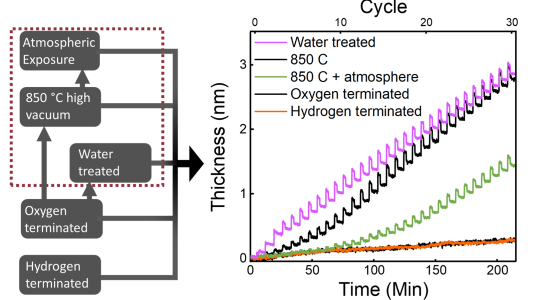
Scientific Achievement
- Atomic layer deposition (ALD) was used to probe the differences in surface chemistry of diamond 001 terminations for the first time.
- This technique can be used both as an analytical technique to give information about surface chemistry and as a deposition/passivation method.
Significance and Impact
- Diamond surface termination is extremely important for quantum sensing and device integration.
- This work paves the way for a facile termination characterization methodology as well as in-situ quantum relevant surface passivation schemes.
Research Details
- ALD is gas-solid surface reactions, here the reactivity surface terminations can be modified in situ or probed by the deposition of Al2O3 on the diamond surface.
- In-situ treatments had significantly altered surface chemistry as demonstrated by the effect on nucleation of material on the surface.
Argonne National Laboratory seeks solutions to pressing national problems in science and technology. The nation’s first national laboratory, Argonne conducts leading-edge basic and applied scientific research in virtually every scientific discipline. Argonne researchers work closely with researchers from hundreds of companies, universities, and federal, state and municipal agencies to help them solve their specific problems, advance America’s scientific leadership and prepare the nation for a better future. With employees from more than 60 nations, Argonne is managed by UChicago Argonne, LLC for the U.S. Department of Energy’s Office of Science.
The U.S. Department of Energy’s Office of Science is the single largest supporter of basic research in the physical sciences in the United States and is working to address some of the most pressing challenges of our time. For more information, visit https://energy.gov/science.